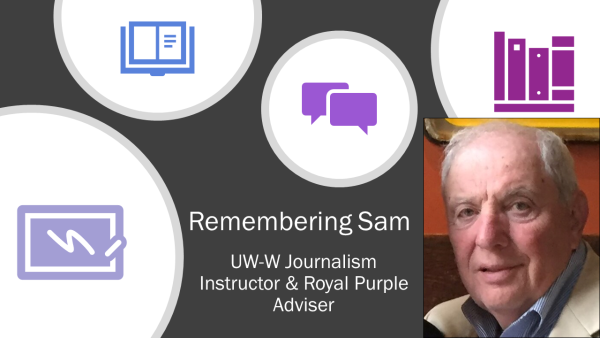Crossroads of thought
December 13, 2017
Failure to accommodate to Native American students, violence against women and queer identity within in Shakespeare’s works were among a range of topics students touched on during the first annual Language Crossroads mini-conference.
Language Crossroads mini-conference co-organizer Elena Levy-Navarro said she and two other professors had wanted to launch the event featuring English student presentations for several years.
Held from 9 a.m. to 1 p.m. on Dec. 8 in Hyland Hall, the mini-conference drew at least 51 student presenters and multiple other students and faculty members who participated in various discussions.
Although the three organizers haven’t yet established a firm plan as to when the next event of this kind will be held, they said they felt first annual Language Crossroads event was a tremendous success.
The conference helped form a sense of community, said senior Katie Sather, a student coordinator and moderator for the conference.
“As an English major, it’s fun to present to people outside of our shell,” Sather said, adding that the conference allowed students to vocalize their ideas to peers and formulate additional ideas through discussions.
“Always learning something new is useful, and I like listening to other people’s work,” Sather said. “We got to see semester-long research projects come together.”
Junior Angelo Faris agreed, saying the conference allowed students to catch a glimpse of what other students were learning in their classes.
“It’s valuable to see what other people are learning,” Faris said. “I think there’s a lot of potential here.”
Faris described the presentations as being a crash course in each specific subject. He added that the conference could help offer students an overview of certain classes they might want to take in future semesters.
Languages & Literatures Department Chairwoman Dr. Elena Levy-Navarro said the three faculty members who organized the conference have been looking forward to it for a long time and the aim was to get more students involved.
“Usually students find it valuable to get [comprehensive] experience by presenting to classmates,” Levy-Navarro said. “The focus the quality of their papers are higher as a result.”
Levy-Navarro helped to organize the event with two other faculty members, Dr. Rossitza Ivanova and Dr. John McGuigan. They required all of their students to participate.
“Students rise to all sorts of challenges,” Levy-Navarro said. “We wanted to give them an egalitarian experience; it helps you own your voice.”
“Each student at their conference brought their own ideas to the discussions, which helped to provide a richer experience”, Levy-Navarro said.
“I was glad to see students taking ownership of their education,” Levy-Navarro said. “That, to me, is really great.”
Although a specific plan has not been set in place for future conferences, the three instructors look forward to organizing another similar event in the future, perhaps once each academic year in order for it to be sustainable.
“I thought it was a pretty big success, so we’re likely to do it again,” Levy-Navarro said.
Shakespeare’s queer Identity
During the kick off presentations, three students, junior Cole Pinno, senior Colin Grice and junior Zhishu Wang presented their research works on evidence of queer identity in Shakespeare’s work.
Pinno chose to look at Shakespeare’s sonnets, looking at certain writing aspects such as puns and double entendre. Pinno said he wanted to tackle the research in a way that would start at the very surface of these writing elements and then dive deeper into the possible double meaning.
As a member of the LGBT+ community, Pinno said he chose to study this topic because he likes to use his voice whenever he can.
Grice chose to focus less on the writing styles, and more on the content like the friendships between characters, that could have homosexual undertones. Bryce mostly focused on the comedic play Two Gentlemen of Verona.
Grice is also a member of the LGBT+ community, and interested in Shakespeare’s writing, so she wanted to bridge the two and research something that was significant in her life.
Finally, Zhishu Wang presented his research on a similar topic. He chose to study the plays “Hamlet” and “As You Like It”, and focused on personal identity in different situations.
He emphasises the difference of how characters act in the plays in the beginning and end, and when they are around other important characters.
As an international student, Wang chose the topic in part because he found himself acting as a different person when he was with different people, and wanted to channel that into his research topic.
Sexual violence in Shakespeare’s works
During the second round of presentations, one panel of four students presented on and led a discussion related to the significance of purity and violence against women in Shakespeare’s works.
The panelists said they believe Shakespeare was alluding to these social issues in his works to bring more attention to the issue of sexual violence.
“In Shakespeare’s time, a woman’s virginity was all she had,” said junior Taylor McGee, one of the panelists.
In much of Shakespeare’s works, the consequences of rape were prominent, as female characters were portrayed as not to think for themselves, with male figures being responsible for effectively dictating their livelihoods.
Despite many female character in Shakespeare’s works being subjected to violence, the panelists noted that several female characters had character arcs that transitioned from a begging state to an empowered demeanor.
“It’s not within human nature to be submissive,” McGee said.
Native Americans’ troubled education
The third round of presentations featured a group of three students who focused on how Native Americans are impacted by public education systems that don’t provide adequate attention to tribes’ cultural values in their instructional methods.
The public education system is failing Native American students by not offering resources needed for them to be successful, said Sather, who presented on and moderated the discussion on Native Americans’ education.
“Only 13 percent of Native Americans nationwide attend universities”, Sather said.
This compares to the national averages of 63 percent of Caucasians and 48 percent of African Americans who attend college after high school, according to USNews. About 53 percent of Native Americans don’t graduate from high school, Sather said.
“Native Americans miss own on learning of their own cultures in public schools,” Sather said. “They only get part of our attention and are set up for failure.”
The national education system has gone through 33 directors in 36 years for the department that oversees education of Native American boarding schools, Sather said.
Many instructors in Native American boarding schools are white, and tribe’s family values are not taught to students, said senior presenter Natalija Krsteva, adding that assimilation into mainstream education is destructive to Native American students’ success.
During the discussion, Dr. Rossitza Ivanova, one of the event’s organizers, said Native American students often are forced to choose between leaving their tribes to pursue public education or remain with their families and miss out on receiving an education. Access to jobs is also very limited on reservations.













Christine Pieper • Dec 15, 2017 at 12:34 pm
Congratulations to these students for voicing their opinions and engaging in thoughtful discussion. Immensely proud of them to think of others and to care about what others learn as well. Bravo!